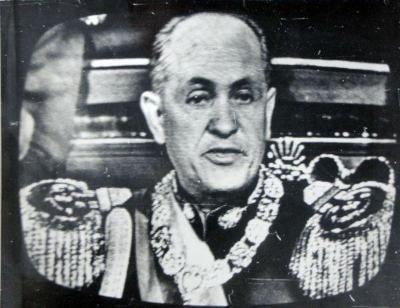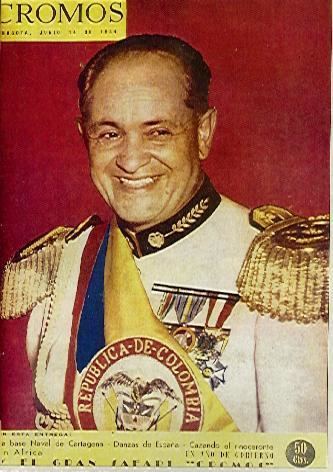Spouse Carola Londono (m. 1930) Name Gustavo Pinilla | Nationality Colombian Education Trine University | |
 | ||
Preceded by Jose Vicente Davila Tello Succeeded by Jose Tomas Angulo Lourido Born 12 March 1900Tunja, Boyaca, Colombia ( 1900-03-12 ) Died January 17, 1975, Melgar, Colombia Presidential term June 13, 1953 – May 10, 1957 Children Maria Eugenia Rojas Correa Similar People Laureano Gomez, Alberto Lleras Camargo, Jorge Eliecer Gaitan, Mariano Ospina Perez, Maria Eugenia Rojas Co | ||
Preceded by Laureano Gomez Castro Succeeded by Alberto Lleras Camargo | ||
SYND 22 4 70 RIVAL CANDIDATES CLAIM VICTORY IN COLOMBIAN PRESIDENTIAL ELECTIONS
Discurso Gustavo Rojas Pinilla - Toma del mando presidencial - 1953
Gustavo Rojas Pinilla (12 March 1900 – 17 January 1975) was the 19th President of Colombia from June 1953 to May 1957. An Army General, he mounted a successful coup d'état against the incumbent President, Laureano Gómez Castro (1889—1965), imposing martial law and establishing a dictatorship-style government in Colombia.
Contents
- SYND 22 4 70 RIVAL CANDIDATES CLAIM VICTORY IN COLOMBIAN PRESIDENTIAL ELECTIONS
- Discurso Gustavo Rojas Pinilla Toma del mando presidencial 1953
- Biographic data
- Early years and education
- Military career
- Political career
- Coup detat
- Presidency
- Presidential Candidate
- References
Biographic data

Rojas was born in the city of Tunja, Boyacá, on March 12, 1900, and died in Melgar, Tolima, on January 17, 1975.
Early years and education
Gustavo Rojas Pinilla began his career in the school of cadets Escuela Militar de Cadetes Gral. José María Cordoba of Bogotá in 1917. He obtained his degree in 1920. In 1923 while serving in Manizales, Caldas, he was promoted to lieutenant in the army. He became dissatisfied with the army and in 1924 he requested permission to retire from active service so that he could study civil engineering in Tri-State Normal College, in the United States where he obtained the title of civil engineer in 1927. From there he started taking part in the construction of highways and other works of engineering as part of his military career.
Military career
In 1932, Rojas was called to the front lines in order to defend the country in the war against Perú. The following year he was assigned to Buenaventura's port as commander of the Coast Battery and military engineer of the region in case of a Peruvian attack. In 1936, he became an engineer of the technical department of the Colombian Army, ammunitions factory, on behalf of which he was sent on a special mission to Germany to obtain the machinery necessary to make ammunitions in Bogotá. On his return to Colombia he was nominated as chief of the technical department of the munitions factory.
In 1943, he was sent to the United States to acquire weapons and other machinery for the Colombian military. In 1944, he became assistant director of the School of War, and in 1945 the director of Civil Aeronautics. It was there where he presented his project for airports in Colombia under the name "Tracks of landing in Colombia," which served as a dissertation for his promotion to colonel of the Army, a plan which he would subsequently bring into being with the El Dorado Airport and other airports during his later presidency.
In 1946, now a colonel, Rojas was nominated as commander of the First Brigade in Tunja and in 1948 was named commander of the Third Brigade in Cali. There, he gained major recognition in the country for having managed to appease the rebellion that happened in this region as a consequence of the assassination of the popular leader Jorge Eliécer Gaitán on April 9, 1948, for which he was honoured by the incumbent Conservative President Mariano Ospina Pérez. On October 11, 1949, he was promoted to General and on October 19 assigned to the Central Command of the Army.
Political career
On December 3, 1949, Rojas was appointed as Minister of Posts and Telegraphs in the government of President Mariano Ospina Pérez.
In 1951, he was nominated as a delegate for Colombia to the United Nations in Washington, and as such he inspected the Colombia Battalion, then attached to the American 21st Infantry Regiment in Korea. In 1952, he was ascended to General of the Army and appointed as Chief of Staff of the Armed Forces of Colombia by President Roberto Urdaneta Arbeláez.
Coup d'etat
On June 13, 1953, Rojas led a peaceful coup d’état conceived by Conservative and Liberal parties to reestablish peace and political order in the nation.
Rojas was military dictator of Colombia from 1953 to 1954. He was designated President of Colombia in 1954. The National Constituent Assembly, by its Legislative Act Number 1 of 1953, appointed him as President of Colombia without a popular election.
Presidency
Rojas enacted legislation that gave women equal rights to vote. He introduced the television and constructed several hospitals, universities and the National Astronomic Observatory. He was also a strong supporter of public works and infrastructure, promoting and conducting projects such as the Atlantic railway, the hydroelectric dam of Lebrija, and the oil refinery of Barrancabermeja.
On May 10, 1957, the people of Colombia, dissatisfied with the government of Rojas, launched a massive national protest demanding his resignation. Rojas was ousted and the events of this day were called a “coup d'état of public opinion”. A military Junta of five Generals assumed control of the nation.
The military Junta was made up of: General Gabriel París Gordillo, General Rafael Navas, General Luis E. Ordóñez, General Deogracias Fonseca and Admiral Rubén Piedrahita. The Junta ruled until 1958, when a plebiscite adopted an 1886 Constitution as Magna Chart, and General Gabriel París Gordillo was elected as Chairman of the Colombian Military Junta of Government.
Presidential Candidate
In the election of 1962 Rojas ran a first time as the presidential candidate of his newly created ANAPO opposition party. He came in fourth, but his result was nonetheless declared invalid due to him being a former coup leader.
In the election of 1970 he ran again for the presidency, with a populist platform. He was defeated by a narrow margin by Misael Pastrana, but alleged that this was the result of fraud.
The presidential election of April 19, 1970, was difficult and controversial. Rojas and Misael Pastrana Borrero were both running for office. Rojas seemed to be winning the elections until a nationwide malfunction of communication systems happened. After these were restored, the votes had already been counted. The results were very close, giving a slight margin in favor of Pastrana Borrero. The supporters of Rojas challenged the results and accused the government of President Carlos Lleras Restrepo of fraud. The case was brought before the Electoral Court, which ruled in favor of Pastrana Borrero on July 15, 1970, certifying him as President of Colombia. This alleged electoral fraud led to the formation of the 19th of April Movement.
